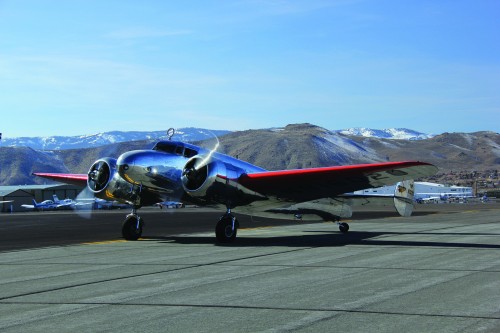Image: CLICK FOR HI-RES, from Museum of Flight.
Press Release:
On March 9, 2013, aviator and adventurer Dottie Simpson announced that The Museum of Flight will add a uniquely restored, antique Lockheed Model
10-E aircraft to its collection. This is the same type of plane Amelia Earhart was flying on her ill-fated attempt to fly around the world in 1937. The aircraft will be flown to the Museum during late summer 2013 and become the centerpiece of a new exhibit honoring Earhart. The Museum already owns the only known piece of Earhart’s Electra. This artifact and the airplane will help tell the story of the world’s most famous women aviator in ways that cannot be found in any other museum.
The Museum’s Electra
In the late summer of 2012, The Museum of Flight launched a now-successful fundraising campaign to acquire an Electra. The aircraft the Museum has taken ownership of has had many different owners, designations and exterior color schemes. Let’s take a quick look at its 78-year history.
The Electra was built as a Model 10-A and registered as NC14900. The 15th Electra built by Lockheed, NC14900 was delivered in 1935 to Northwest Airlines, the first airline to put the Electra into service.
After the attack on Pearl Harbor, NC14900 was ’œdrafted’ into the U.S. Army Air Forces, along with many other Electras. Redesignated a UC-36A, painted camouflage and given the USAAF serial number 42-57213, it spent a short time as a VIP transport. Once more military transport aircraft became available, 42-57213 was returned to Northwest in May 1944 and was once again known as NC14900. After the war ended and larger DC-3s were available in surplus, NC14900 was sold to VARIG, the first Brazilian airline and registered PP-VAR. The aircraft also saw brief military service in Brazil, as part of the Brazilian Air Force (and known at this time as FAB-1002.)
Once back in the United States, the aircraft saw many private owners as N2067A before it was returned to Lockheed and completely converted to a Model 10-E configuration. It was then registered as N72GT.
In 1994, aviatrix Linda Finch happened upon N72GT, which was one of only two airworthy 10-Es. With the assistance of Pratt & Whitney, the manufacturer of the original engines, and using original Lockheed drawings and vintage photographs, Finch restored the aircraft to the specifications of the most famous Lockheed 10-E the world has ever seen’¦Amelia Earhart’s.
From rivets to the exterior color scheme, and even the historical registration of NR16020 worn on Earhart’s aircraft, Finch faithfully restored the plane. But Finch didn’t just recreate the look of Earhart’s aircraftshe also reenacted Earhart’s flight plan. In 1997, the 60th anniversary of Earhart’s flight, Finch took off. She flew as close to Earhart’s original flight plan as possible (she was unable to fly over Libya and made more stops than on Earhart’s flight plan while crossing the Pacific) and in all, she touched five continents on the journey. While flying over Howland Island, which was to be Earhart’s final destination, Finch dropped a wreath in salute of Earhart and her navigator Fred Noonan.
Among the thousands of items in the Museum’s collection is a piece of crumpled metal approximately 4 inches by 5-and-a-half inches in size, which could be easily passed over by the casual observer. Yet this scrap of aluminum holds a significant place in aviation historyit is the only known piece remaining of Amelia Earhart’s Lockheed 10-E Electra.
Quick facts about the Lockheed Electra:
The Lockheed Model 10 Electra was famed engineer Clarence ’œKelly’ Johnson’s first assignment with the Lockheed Aircraft Corporation. Then a lab assistant at the University of Michigan, Johnson was asked to redesign the aircraft’s tail surfaces after identifying stability issues during wind-tunnel tests.
Only 149 Model 10 airplanes were constructed, with four commercial series (10-A, 10-B, 10-C and 10-E) and five military versions (XR2O-1, XR3O-1, XC-35, Y1C-36 and Y1C-37.)
The Electra was Lockheed’s response to the Douglas DC-2 and the Boeing 247, which had revolutionized commercial airline service in the United States. The Model 10 was both fast (190 mph) and comfortable for passengers.
